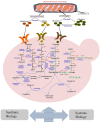Engineered yeasts and lignocellulosic biomaterials: shaping a new dimension for biorefinery and global bioeconomy
- PMID: 37850721
- PMCID: PMC10586088
- DOI: 10.1080/21655979.2023.2269328
Engineered yeasts and lignocellulosic biomaterials: shaping a new dimension for biorefinery and global bioeconomy
Abstract
The next milestone of synthetic biology research relies on the development of customized microbes for specific industrial purposes. Metabolic pathways of an organism, for example, depict its chemical repertoire and its genetic makeup. If genes controlling such pathways can be identified, scientists can decide to enhance or rewrite them for different purposes depending on the organism and the desired metabolites. The lignocellulosic biorefinery has achieved good progress over the past few years with potential impact on global bioeconomy. This principle aims to produce different bio-based products like biochemical(s) or biofuel(s) from plant biomass under microbial actions. Meanwhile, yeasts have proven very useful for different biotechnological applications. Hence, their potentials in genetic/metabolic engineering can be fully explored for lignocellulosic biorefineries. For instance, the secretion of enzymes above the natural limit (aided by genetic engineering) would speed-up the down-line processes in lignocellulosic biorefineries and the cost. Thus, the next milestone would greatly require the development of synthetic yeasts with much more efficient metabolic capacities to achieve basic requirements for particular biorefinery. This review gave comprehensive overview of lignocellulosic biomaterials and their importance in bioeconomy. Many researchers have demonstrated the engineering of several ligninolytic enzymes in heterologous yeast hosts. However, there are still many factors needing to be well understood like the secretion time, titter value, thermal stability, pH tolerance, and reactivity of the recombinant enzymes. Here, we give a detailed account of the potentials of engineered yeasts being discussed, as well as the constraints associated with their development and applications.
Keywords: Bioengineering; bioeconomy; biorefineries; lignocellulosic materials; metabolic pathways; synthetic yeasts.
Plain language summary
Metabolic pathways of an organism depict its chemical repertoire and its genetic makeup.Autonomous synthetic microbes can be developed for lignocellulose biorefinery (LCB).LCBs can be harnessed with synthetic microbes to boost global bioeconomy.Yeasts can be engineered to enhance downstream process of LCB.
Conflict of interest statement
No potential conflict of interest was reported by the author(s).
Figures



References
-
- Amponsah NY, Troldborg M, Kington B, et al. Greenhouse gas emissions from renewable energy sources: a review of lifecycle considerations. Renew Sust Energ Rev. 2014;39:461–31. doi: 10.1016/j.rser.2014.07.087 - DOI
-
- Martinez-Hernandez E, Campbell G, Sadhukhan J.. Economic value and environmental impact (EVEI) analysis of biorefinery systems. Chem Eng Res Des. 2013;91(8):1418–1426. doi: 10.1016/j.cherd.2013.02.025 - DOI
-
- Liu G, Qu Y. Integrated engineering of enzymes and microorganisms for improving the efficiency of industrial lignocellulose deconstruction. Eng Microbiol. 2021;1:100005. doi: 10.1016/j.engmic.2021.100005 - DOI
-
- Santos VEN, Magrini A. Biorefining and industrial symbiosis: a proposal for regional development in Brazil. J Clean Prod. 2018;177:19–33. doi: 10.1016/j.jclepro.2017.12.107 - DOI
Publication types
MeSH terms
Substances
LinkOut - more resources
Full Text Sources
Other Literature Sources
Miscellaneous
